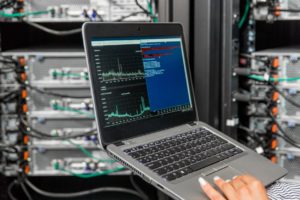In the ongoing battle to maintain business information security, the tools we use are our most important defenses. Firewalls, anti-virus, encryption. But the best tool we have to defend against hackers is something you may have barely even heard of, Network Monitoring.
Network Monitoring is Cybersecurity’s Secret Weapon
Network monitoring, summarized, is keeping track of every single detail of your physical computers and devices, digital files and servers, and your internal network activity. But the reason it’s so obscure is that explaining network monitoring is incredibly technical. It triggers most people’s ‘Techno-Babel’ filters. Network monitoring is cybersecurity’s secret weapon is because it gathers -all- the data.
Network monitoring allows you to build a fortress with data. Not the precious personal and financial data the hackers want to steal. Just cold hard facts about your computers. You can zoom in as tight as the motherboard temperature or as wide as watching data flow through your network. And network monitoring can create a record of data over time, no matter what you are tracking, which allows patterns to be spotted and, therefore, deviations from normal patterns to raise alarms.
But to put it simply, it’s like placing security cameras on the data itself. Right inside the server, looking at the files you’re protecting and the network hackers are -required- to come through to access your internally stored data. Now let’s take a look at some of the highly useful practical applications for network-monitored defenses.
Unauthorized Network or Data Access
The problem with hackers is that they access your data without permission, or slip onto your internal network and start infecting endpoint devices. But to do this, they need a way in. They will need to, at some point, access your network through a stolen or unauthorized channel. Or they will try to access your data with a malware program instead of using the secured software access built for employees. In fact, hackers like to break the rules. They enjoy slipping around your normal protocols to steal your data or ruin your network.
But here’s the thing: Your ‘normal protocols’ create a certain pattern of data. Like watching waves on a shore, network monitoring set to watch specific files or network access knows what an authorized employee access looks like. And if anything else happens to those files or enters your network without following known employee protocols, network monitoring can trigger its hacker alarm and start messaging admins.
Signs of Stolen Login Credentials
You might be thinking “What if a hacker steals an employee’s password”. Stolen credentials are a very serious concern in business security because there are so few real solutions to the problem. Employees need to be able to log in from anywhere and to use their logins to do their normal work tasks. But what you can do is set up network monitoring to alert for suspicious authorized login behavior.
When an employee logs in from a mobile device or home computer, it is possible to record the IP address and get the general location of the login. There is also usually a date, timestamp, and sometimes the name of the device used. Your employees are going to have a normal set of devices and locations they log in from. Each login can then be pattern-matched to a certain set of devices and a geographical region that network monitoring can learn to recognize.
This means that network monitoring will also notice if that login is suddenly used on a new device in an unusual location, or suddenly in a new state or halfway across the world. Or at a time in which that login has never logged in before.
Checking in when patterns change is also the best and only way to consistently catch hackers who steal authorized logins. And if it’s something normal like a business trip or device upgrade, then no harm was done simply by touching base with the person who’s login was flagged.
Managed network monitoring is an incredibly powerful tool and these capabilities are only the beginning. Join us next time for the second half of this article where we’ll talk about misconduct, corporate espionage, compromised software, and detecting hidden malware programs. Contact us today for more information about network security, managed network service, or to set up managed network monitoring for your business needs.
See you next time!
